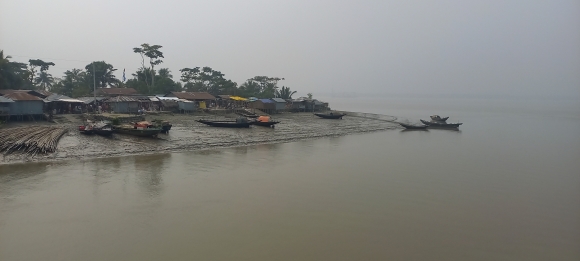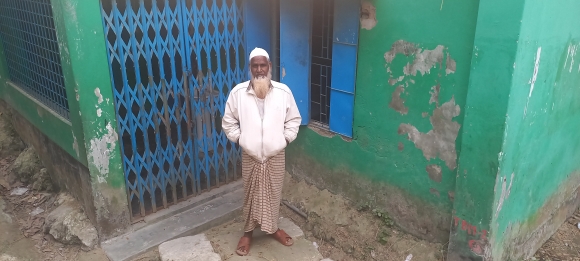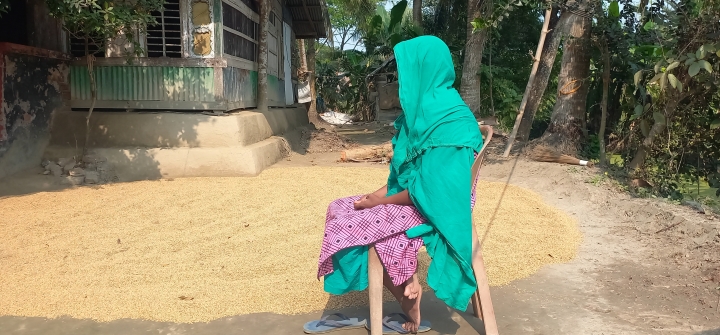Climate Change Drives Anxiety, Depression in the Sundarbans
BAGERHAT, Bangladesh — In Teligati village along the coastal belt of the Sundarbans, 32-year-old Parveen Akhtar spends most of her time cooped up in her house—a fragile structure weary from the frequent landfall of cyclones.
When cyclone warnings sound in her village, Akhtar routinely refuses to move to a shelter.
In 2009, Cyclone Aila devastated the area and turned Akhtar’s life upside down. She fell hard in the floodwater and quickly developed a fever that forced her to spend long stretches in government hospitals in subsequent years. Doctors ultimately diagnosed Still’s Disease, a rare type of inflammatory arthritis.
By 2016, her mental health also deteriorated. “I grew restless to go home all of a sudden. I would start walking … I would insist that the doctors give me injections and kill me,” she says.
Eventually with medication and counselling, her mental health stabilized, and much to her relief, she was sent home.
Leaning back on a chair with a scarf covering draped around her frail body, Akhtar traces her misfortune back to leaving her house during Aila. So when Cyclone Amphan brought extreme floods to her village in 2020, she stayed in bed.
“Whatever will happen will happen when a flood or cyclone hits my wooden house,” says Akhtar. The storm and the floodwater battered the mud house, and rain poured through the gaping holes in the tin roof.

Sundarbans villages like this one in Bangladesh’s Bagerhat district are affected by rising sea levels and more frequent cyclones. Ritwika Mitra, Jan. 1, 2023
For Akhtar and thousands of others, life in the Sundarbans—a vast mangrove forest shared by India and Bangladesh on the Bay of Bengal—means weathering cyclones. Historically, the storms hit Bangladesh an average of 1.58 times every year. But climate change is increasing their frequency, say Bangladeshi researchers. In the past two decades, the Sundarbans alone has seen over 20 major cyclones.
The result is a growing anxiety among people of the ecologically fragile forest. The disasters reduce economic opportunities, destroy agriculture, shrink incomes, and destabilize housing and other determinants of mental health.
The people of the Sundarbans have been hardened by their long history with adverse weather events, says Professor Saleemul Huq, director at the Dhaka-based International Centre for Climate Change and Development.
However, their resilience—and mental health—is being tested by the worsening climate.
‘Do not feel good’
In the aftermath of Aila in 2009, researchers from the Kolkata-based National Institute of Behavioural Sciences (NIBS) said they saw a rapid increase of patients with PTSD symptoms, especially among women, who bear a disproportionate impact of climate devastations.
One morning in September 2022, as West Bengal prepared for Durga Puja—one of the state’s most popular festivals—NIBS’ Dr. Kedar Banerjee wondered if any patients would turn up at his monthly mental health clinic in Rangabelia village. Soon, however, nearly two dozen patients had queued up outside.
The diagnoses of the clinic’s patients are diverse: schizophrenia, anxiety, PTSD, bipolar disorder, autism spectrum disorder, and so on. Several patients complain, “Aaj kal kichu bhalo lagche na.” (“We do not like anything these days.”)
“After disasters, patients complain of sleeplessness, loss of appetite, and recurring memories of the cattle drowning, children being swept away, house roofs collapsing,” says Banerjee. “They also have palpitations, thinking of an impending doom. This happens during any time of the day. Patients say they are unable to bear the pain and that they feel like dying. Children often do not want to go to school, and parents also feel anxious to part with them.”
For Banerjee, climate change’s impact on the mental health of the people of Sundarbans is obvious. “With the frequency of climatic events increasing, this is only going to get worse,” he says.
Fear and anxiety are constants
In Teligati village, 19-year-old Swarna Akhtar (no relation to Parveen) feels fear and anxiety rush through her body every time she thinks about the time the rains flooded her village. The bouts of anxiety intensify when she thinks about the health of her 8-month-old son and a storm that hit two months before.
“We ran to take shelter at a relative’s house as it was a concrete building. I was scared to stay in our house,” she says. “When I hear of the flood level rising, I feel fear in my heart.”
Married for three years, the teenager talks about rising sea levels and floodwaters more frequently entering households. “My mother-in-law feels anxious all the time thinking about the cyclones and floods,” she says. “What will happen when the house collapses? We do not have the financial capacity to rebuild it.”
Previously, Swarna Akhtar had dreamt of having a career. Now, that dream is history. Her husband works as a mason, and her father-in-law runs a small tea shop by the road. These days, she suffers from palpitations and restlessness. She also suddenly has the urge to sleep and not engage in any activities during the daytime.
“When I went to the doctors, they treated me for gas issues and heart [problems],” she says. “There has been no improvement from the medicines and injections.”
Social anthropologist Upasona Ghosh, who has worked extensively in the Sundarbans, said it is time to address the mental health challenges there through targeted programs and policies.
“Climate change is creating uncertainties in all spheres of people’s lives. The major uncertainties are related to traditional agro-fishing livelihoods,” says Ghosh. “Securing food for the family on a daily basis is making people anxious and depressed. There are also the uncertainties of losing shelter due to erosion, and how they would secure the future of children and families.”
Scars of Sidr
One afternoon, Shahjahan Khan, 65, stands staring at a school building in Sarankhola village. The scars of 2007’s Cyclone Sidr will never fade for him or his wife.
Two hundred and fifty of the 350 people who had taken refuge in the school had died. Among them were two of their children.

Shahjahan Khan pauses at the site in Sarankhola village, Bangladesh, where 2 of his children died during Cyclone Sidr in 2007. Ritwika Mitra, Dec. 31, 2022
“Bhoy ache. Batash uthlei toh bhoy. Bonyar signal porlei bhoy, Sidr por toh mathai kharap, charidike sudhu gach, ekta pata nei… khali dal. Mone koro ei toh, ek ghonta du ghonta r modhye ki hoe gelo… ei school er sob bhenge churmar.” (“We have fear. Every time there is wind, there is fear. Every time there is a warning that there would be flood, there is fear,” Khan says. “After Sidr, we lost our minds. Everywhere there were trees but no leaves…only branches. In a couple of hours, so much happened, the school crumbled.”
While the school was later rebuilt, Khan and his wife are still picking up the pieces of their lives.
Christian Schweizer, a WHO climate change and health scientist, says mental health policies and programs need to be integrated into countries’ national action plans for climate change. “Currently, the lens of inter-sectorality is still largely missing when it comes to the climate-related mental health burden that a population is facing,” says Schweizer. A 2021 WHO survey of 95 countries showed that only nine had included mental health and psychosocial support in their national health and climate change plans.
“Though a lot of countries are talking about the climate crisis, mental health is not yet adequately considered in the discourse at the policy level,” he adds.
For people living in the Sundarbans, even incremental progress counts as a victory. Though Parveen Akhtar is not sure she can ever complete the master’s program that she was forced to drop because of her poor health, she has one ray of hope: her 3-year-old niece.
“I even left the house and went to our relative’s house to take shelter the last cyclone [Sitrang]. It was only because of this one,” she says, gazing fondly at her niece.
Ritwika Mitra is an independent journalist based in India.
Reporting for this story was made possible by the Médecins Sans Frontières (MSF) Without Borders Media Fellowship. MSF, also known as Doctors Without Borders, works with journalists to encourage independent, impartial, and neutral reporting on health and humanitarian crises.
Join the 50,000+ subscribers in 170+ countries who rely on Global Health NOW summaries and exclusive articles for the latest public health news. Sign up for our free weekday newsletter, and please share the link with friends and colleagues.
Parveen Akhtar sits in front of her storm-battered home in Teligati village on Dec. 29, 2022. Ritwika Mitra




